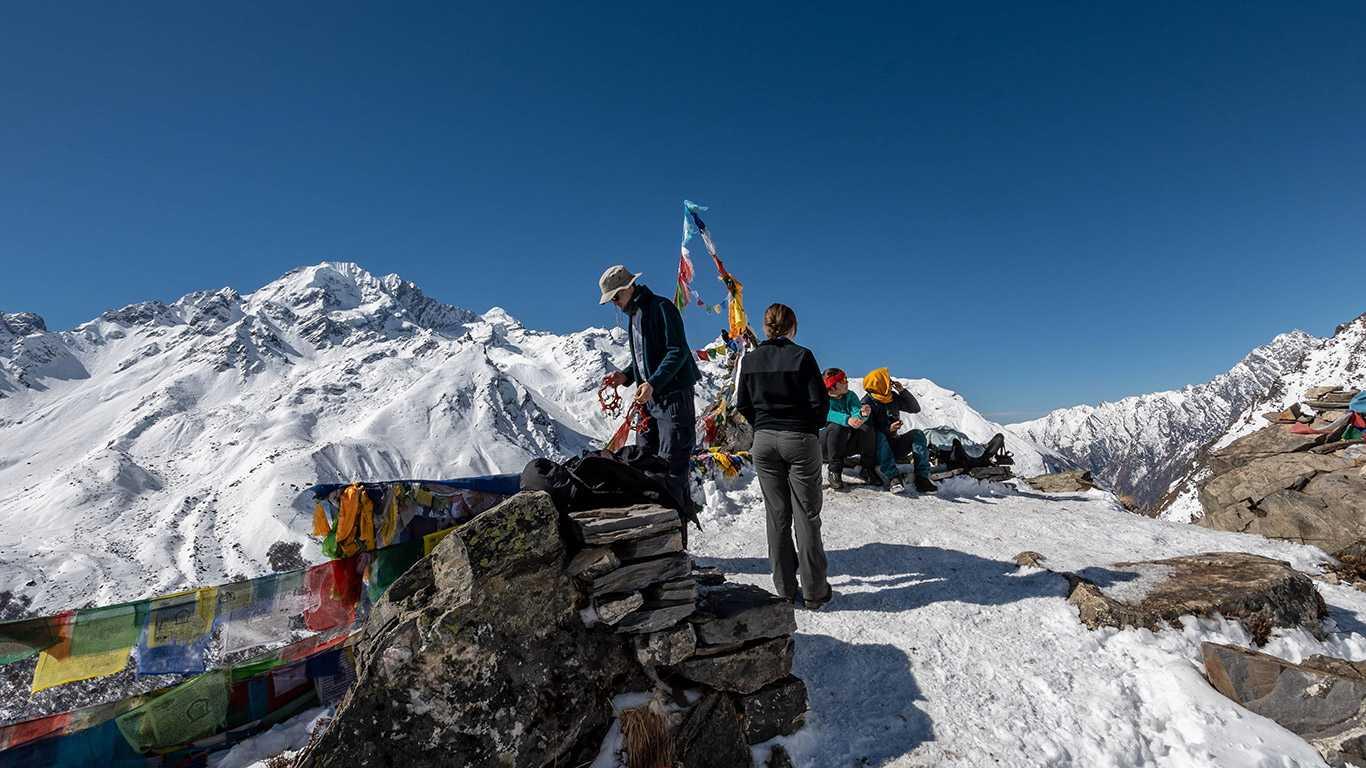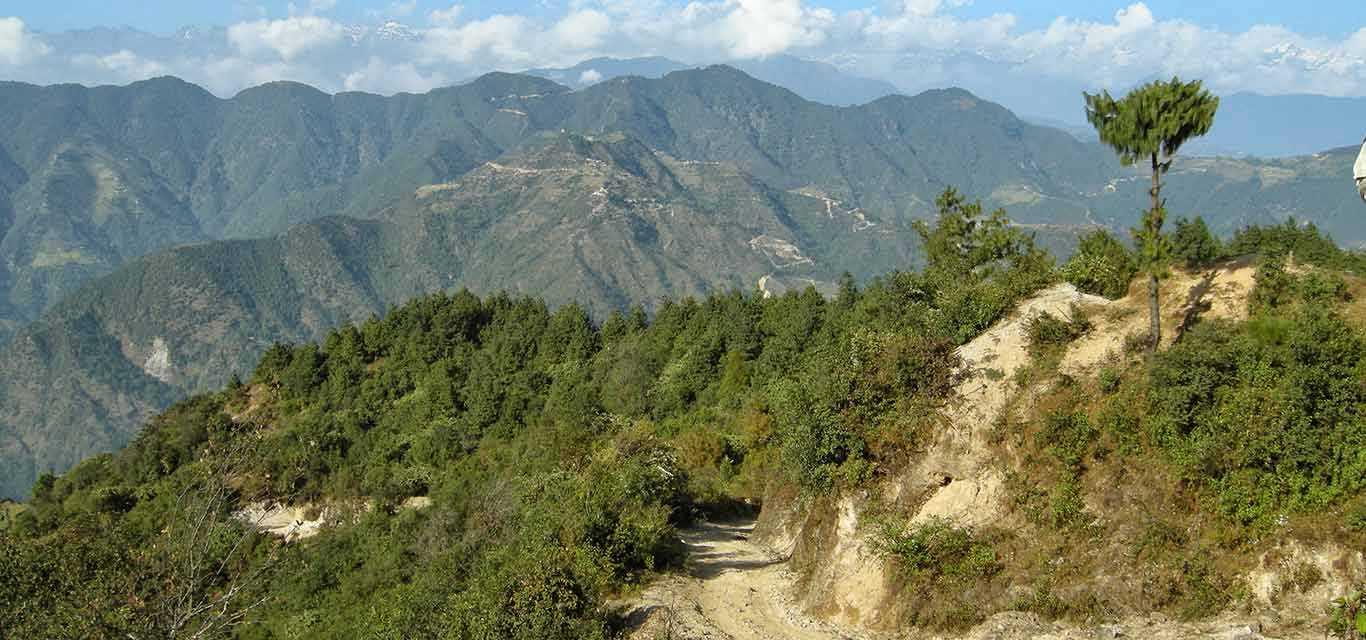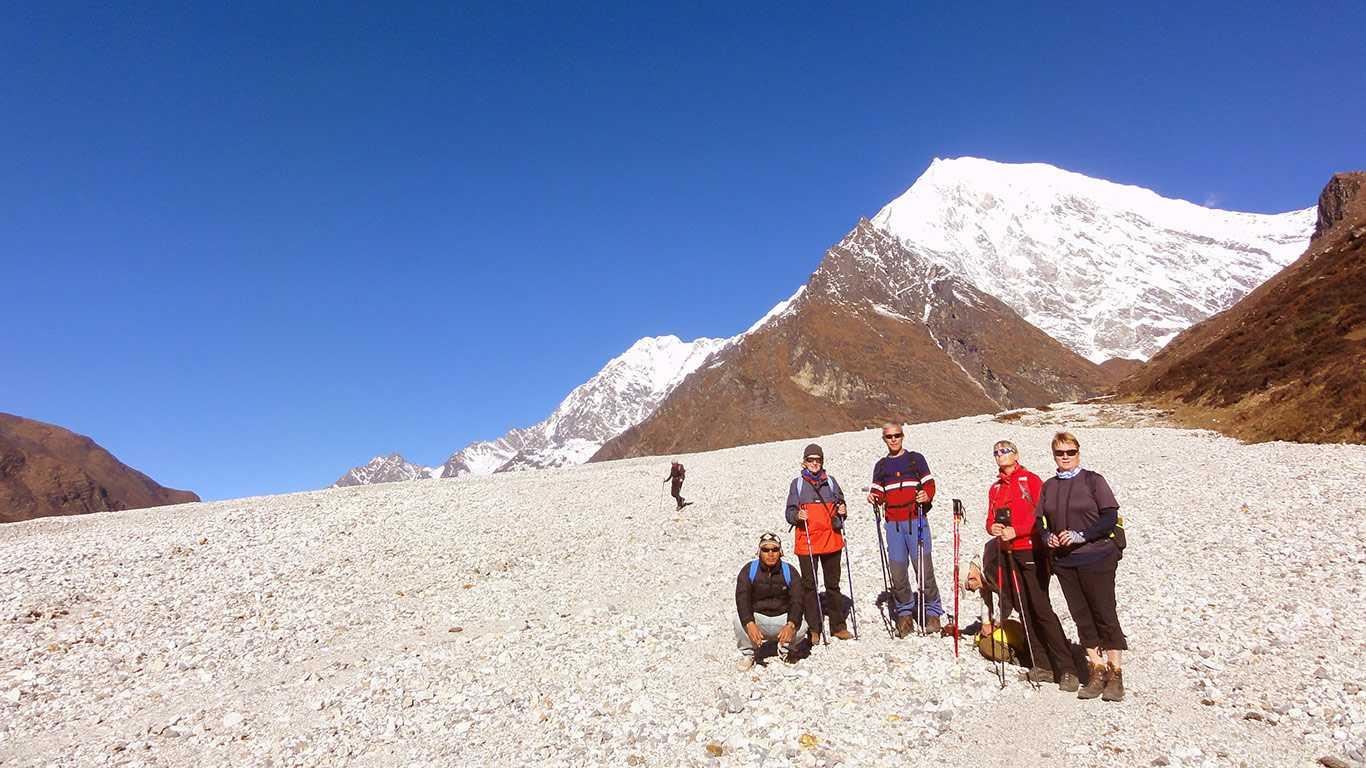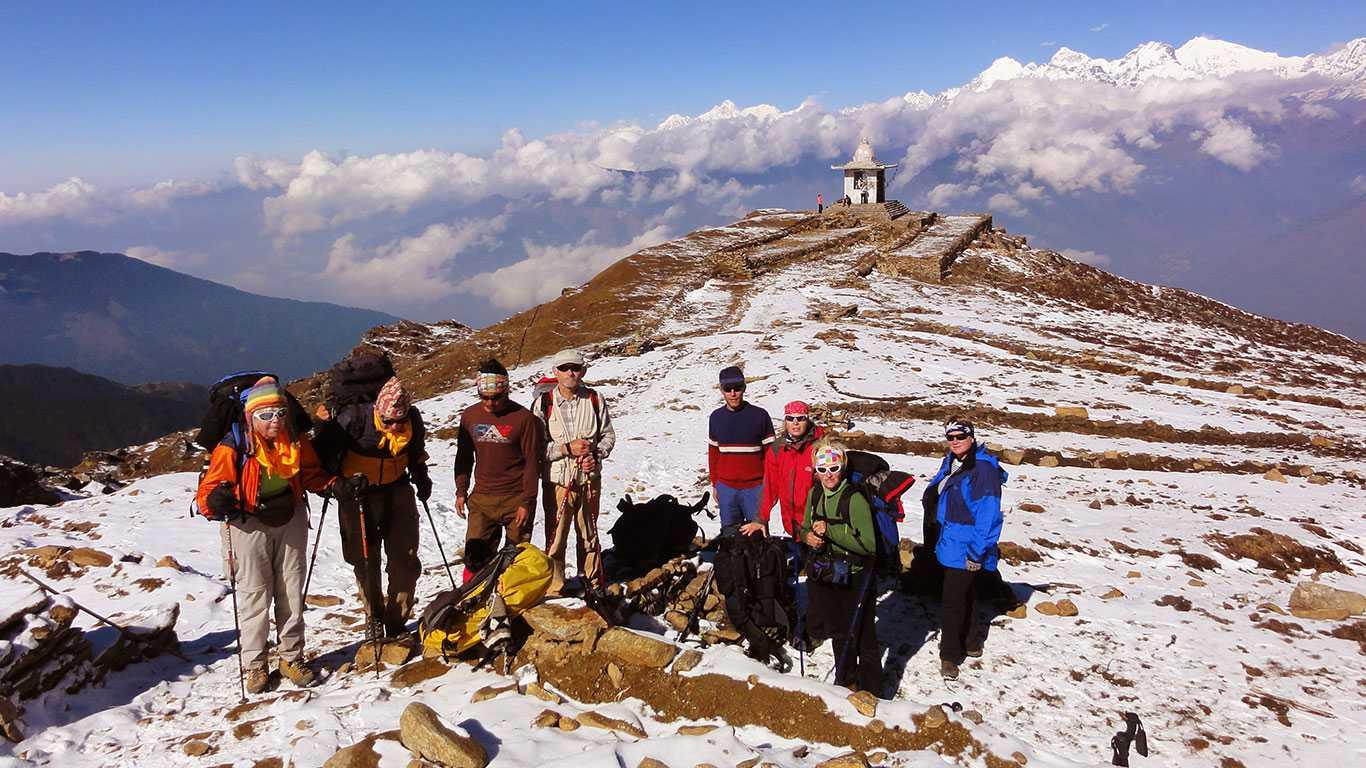
A TREKKER’S PARADISE
Langtang Helambu region, also known by the name of the Valley of Glaciers, is known for its combination of rich culture, beautiful scenery, diversified flora and fauna, and challenging trekking routes, making it a paradise for explorers. Explained as a sacred place that feels like heaven itself, anyone who visits will fall in love with the overall environment.
A major heavenly element of the Langtang Helambu region comes in the form of Langtang National Park. With a diverse range of flora, including chirpine, Nepalese alder, and rhododendron, and fauna, including musk deer, Himalayan tahr, and the red panda, the national park is a utopia for those who enjoy nature and wilderness.
The thrilling experience gained while watching the amazing and breathtaking views of majestic mountains, like Langtang Lirung, Pemathang Ri, Kyanjinj Ri, and more, is simply incomparable. The serene and peaceful environment around Lake Gosainkunda will connect visitors with nature on a deeper spiritual level.


SYMPHONY OF NATURE AND CULTURE
The perfect mixture of nature and culture in the Langtang Helambu region is what makes it worthwhile to visit it. Taking travelers through lush forests, magnificent waterfalls, and snow-capped mountains allows them to connect with the spirit of nature, regardless of how tired they are.
Passing through the traditional villages of the Sherpa, Bhotias, and Tamang communities provides them with an opportunity to see and experience the local life, traditions, and customs of these communities.
Trying out different traditional foods like dal bhaat, thukpa, and gundruk and watching ancient dances like Tamang Selo and Syabru in a comfortable and friendly environment is no less entertaining than live concerts.
Visiting during major festivals like the Tarna Festival and Janai Purnima will provide a colorful and vibrant feeling that is totally priceless.
A quick trip to ancient monasteries, like Kyanjin Gompa and Sing Gompa, allows travelers to immerse themselves in the spiritual practices of these communities.
Langtang & Helambu Treks packages
Do most treks in the Nepali Himalayas intimidate you? Then you can opt to go on a journey in the Langtang & Helambu region. The region is very close to Kathmandu. That makes it ideal for first-timers and new trekkers. But don’t let that fool you. Langtang & Helambu offer striking landscapes and deep-rooted cultural charm.
Another key attraction to Langtang & Helambu is fewer crowds. But like Annapurna and Everest, Langtang & Helambu offer dramatic views. Moreover, the area also has mystical forests, glaciers, yak pastures, and vibrant traditions. The place is filled with spiritual calm and alpine challenges.
So, where is the Langtang & Helambu region? The territory is in the North of Kathmandu. Likewise, the elevation ranges from 1,460 meters to 4,984 meters. The trailhead starts from Syabrubesi. Langtang is around 122 kilometres from the capital. Similarly, Helambu is 70-80 kilometres away from Kathmandu.
Coordinates:
Langtang Valley: 28.2125° N, 85.5569° E
Helambu Region: 27.8600° N, 85.5267° E
Why Trek in the Langtang & Helambu Region?
Easily accessible from Kathmandu.
Just a few hours’ drive from the capital offers a true Himalayan experience.
Breathtaking views of Langtang Lirung, Ganesh Himal, and surrounding peaks.
Rich cultural immersion with the Tamang and Hyolmo communities.
Experience centuries-old Tibetan Buddhist traditions that remain vibrantly alive.
Sacred Buddhist heritage, including ancient monasteries, stupas, and Mani walls.
Explore spiritual sites, Kyanjin Gompa and Tarkeghyang Monastery.
Natural hot springs in Tatopani. It’s perfect for post-trek relaxation.
Home to the endangered red panda and other rare Himalayan wildlife.
Hike through subtropical jungles, pine and bamboo forests.
Find vibrant rhododendron forests, bamboo groves, and alpine meadows.
Trek options for all levels. You can choose from short cultural walks to challenging high passes
Langtang & Helambu receive fewer visitors. Treks are more solitary.
Langtang & Helambu offer a more serene trekking experience.
How to Reach the Langtang & Helambu Region
The Langtang & Helambu region is known for its remote feel. But the region is surprisingly more accessible than most. And yeah, no flights required. You pass through scenic foothills, villages, and winding roads.
Road Journey to the Langtang Trailhead:
Before beginning your journey by road, you first land in Kathmandu. Tribhuvan International Airport is the main international gateway. And from here, you begin your journey to the Langtang & Helambu region.
Step one: Road trip to the trailhead
Drive: Kathmandu to Syabrubesi
Distance: 120 Kilometres
Travel Time:
7 – 9 hours: Vans and Jeep
10 – 12 hours: Local Bus
Transport Options:
Local Bus
Shared Van
Private Jeep
Prices:
Local Bus: NPR 800 – 1,200 (approx. $7 – 11)
Shared Van/Microbus: NPR 1,200 – 1,500 (approx. $11 – 14)
Private Jeep (4WD): NPR 18,000 – 22,000 (approx. $ 140 – 170)
Step two: Trek starts at Syabrubesi:
The trek begins from the trailhead, Syabrubesi
Lama Hotel
Langtang Village
Kyanjin Gompa
Reaching the Helambu region by road:
Helambu is the best choice for new trekkers. Likewise, the region offers shorter treks. And like Syabrubesi, you don’t need to take a flight to reach the trailhead, Sundarijal.
Drive: Kathmandu to Sundarijal
Distance: 18 Kilometres
Time: One hour
Transport Options and Cost:
Local Bus: NPR 100 – 200 (approx. 1 – 2 USD)
Taxi or Private Car: NPR 1,500 – 2,000 (approx. 12 – 15 USD)
The trek starts after entering Shivapuri National Park
Practical Tips for Road Travel:
Start early to avoid traffic. Preferably 6 to 7 AM
Reach the trailhead before dark
Carry snacks and water, stops aren’t frequent
Buy a local SIM card in Kathmandu for emergency connectivity
Culture and Community in the Langtang & Helambu Region
Experience a living museum of Himalayan culture in Langtang & Helambu. The ancient Buddhist traditions still thrive in the mountainside of Langtang and Helambu. They shine like golden threads woven into everyday life in this region. You’ll find spinning prayer wheels to bells echoing in the monasteries. Culture is as much a part of the landscape as the forests and glaciers.
Langtang is the soul of the Tamang culture. The valley is predominantly inhabited by the Tamang people. Likewise, they are the descendants of Tibetan settlers from centuries ago. They are deeply tied to Tibetan Buddhism. However, they added a unique local blend to their age-old traditions.
The Tamang people are creative survivors with many skills. They adapted to the higher regions of Langtang and thrived. They are skilled woodcarvers, weavers, and stone masons. Most architecture in their home region is hand-carved. The window frames, prayer wheels, and yes, even the carved stones are hand-made.
Moving to the southeast, Helambu is the heartland of the Hyolmo/Yolmo people. They are an ethnically Tibetan community. And their name literally means “People of Helambu Valley.” They are known for their spiritual and soft-spoken nature. Likewise, Hyolmo people are the guardians of Nepal’s oldest monasteries. Yolmo people look after Tarkeghyang and Sermathang monasteries.
The Hyolmo and Yolmo people’s lives revolve around spirituality and farming. You can find monks chanting and incense-filled prayer halls in Helambu. If you are lucky enough, you can get to hear age-old stories of mountain spirits. These tales are passed down from elders to younger generations.
People of the Region:
Upper Langtang:
Tamangs
Bhotias
Sherpas
Yolmo/Hyolmo
Lower Langtang:
Brahmins
Chhetris
Newars
Gurungs
Helambu:
Yolmo/Hyolmo
Tamangs
Bhotias
Sherpas
Chhetris
Varying Landscapes that Shaped Lives in the Region:
Culture and landscape in Langtang and Helambu are inseparable. As you trek through the region, you can encounter varying scenery. Feel the terrain influence the spiritual practices, architecture, and daily life. You can find subtropical forests to glacier rivers in the region.
In the lower elevations, you find subtropical forests. It’s the home of cardamom, bamboo, and wild orchids. In the mid-hills, you can find rhododendron and pine forests. And above that, you will be greeted with high alpine yak pastures. These places are mostly found near Kyanjin Gompa.
After the alpine area, you reach the glacier-filled place. Life at high elevation can be difficult. These glacier rivers and waterfalls irrigate crops. As such, the people of the region find the glacier sacred.
Popular Packages in the Langtang & Helambu Region
Gosainkunda Heli Tour:
Watch a beautiful aerial view of the Langtang region. Mesmerizing vista of Langtang Lirung, Ganesh Himal, and the Dorje Lakpa. A pilgrimage to the holy Gosainkunda Lake. Enjoy the beauty of a remote alpine environment in a few hours. Here’s what you can expect in the Package:
Duration: 1 Day
Max Altitude: 4,380 Meters
Coordinates: 28.1000° N, 85.3333° E
Difficulty: Easy Traveling
Trip Start: Kathmandu
Trip End: Kathmandu
Accommodation:
Meals: Included in the package
Day Temperature: 18°C to 30°C
Group Size: 2-15
Best Season: Spring/Autumn/Summer/Winter
Tilman Pass Trek
Experience Langtang Valley’s off-the-beaten-path. Uncover Panch Pokhari’s five sacred lakes. Feel the mountain communities' unspoiled spirit and religious significance. Chances of spotting the Red Panda, mountain deer, and national bird – Danfe. Here’s what you can expect from the Tilman Pass Trek package:
Duration: 21 Days
Max Altitude: 5,320 Meters
Coordinates: 28.2236° N, 85.7433° E
Difficulty: Extreme Trek
Trip Start: Kathmandu
Trip End: Kathmandu
Accommodation: Tented Camps/Tea Houses/Resorts/Hotels
Meals: Included in the package
Day Temperature: 5°C to 20°C
Night Temperature: 5°C or below
Group Size: 2-15
Best Season: Spring/Autumn/Summer/Winter
Langtang Budget Trek
Affordable price, and a short trek. Find unique and easy trekking routes. Walk around the Langtang valley. Experience the unique Tibetan Buddhist Tamang culture and Traditions. Breathtaking views of Langtang Lirung, Ganesh Himal, Yala Peak, and other peaks. Here’s what you can get from the Langtang Budget Trek package:
Duration: 10 Days
Max Altitude: 5,000 Meters
Coordinates: 28.2063° N, 85.6229° E
Difficulty: Moderate Trek
Trip Start: Kathmandu
Trip End: Kathmandu
Accommodation: Tented Camps/Tea Houses/Resorts/Hotels
Meals: Included in the package
Day Temperature: 5°C to 20°C
Night Temperature: 0°C to 10°C
Group Size: 2-15
Best Season: Spring/Autumn
Langtang Short Trek
It’s the 3rd most popular trek in Nepal. Experience a cross-cultural journey. Learn about Langtang National Park. Views of Langtang Lirung, Dorje Lakpa, and Langtang Ri. Here’s what you can expect from the Langtang Short Trek package:
Duration: 7 Days
Max Altitude: 3,870 Meters
Coordinates: 28.2333° N, 85.5667° E
Difficulty: Beginner Friendly Trek
Trip Start: Kathmandu
Trip End: Kathmandu
Accommodation: Trek Lodge/Lama Hotel/Hotels
Meals: Included in the package
Day Temperature: 10°C to 20°C
Night Temperature: 0°C to 5°C
Group Size: 2-15
Best Season: Spring/Autumn
Gosainkunda Chisapani Trek
An adventurous trekking experience by witnessing majestic mountains. Cross the Himalayan Pass, Lauribina La Pass. Explore the glacial and holy lake, Gosainkunda, with other lakes. Here’s what you can expect from the Gosainkunda Chisapani Trek package:
Duration: 12 Days
Max Altitude: 4,610 Meters (Lauribina La Pass)
Coordinates:
Difficulty: Moderate Trek
Trip Start: Kathmandu
Trip End: Kathmandu
Accommodation: Trek Lodge/Lama Hotel/Hotels
Meals: Included in the package
Day Temperature: 7°C to 15°C
Night Temperature: -5°C to 3°C
Group Size: 2-15
Best Season: Spring/Autumn
Helambu Chisapani Nagarkot Trek
Trek through the dense forest and beautiful landscapes. Views of many snowcapped peaks. Exciting short trek in the Himalayas. Learn different cultures and lifestyles of the Hyolmo Culture people. Here’s what you can expect from the Helambu Chisapani Nagarkot Trek package:
Duration: 8 Days
Max Altitude: 2,610 Meters (Sermathang)
Coordinates: 27.7715° N, 85.5633° E
Difficulty: Beginner-Friendly Trek
Trip Start: Kathmandu
Trip End: Kathmandu
Accommodation: Trek Lodge/Lama Hotel/Hotels
Meals: Included in the package
Day Temperature: 10°C to 18°C
Night Temperature: 0°C to 5°C
Group Size: 2-15
Best Season: Spring/Autumn
Dorje Lhakpa Expedition
View the beautiful snow-capped mountains. Experience an expedition with the local Sherpa guide. Summit the Dorje Lhakpa peak that stands at 6,966 meters. Here’s what you need to know about the Dorje Lhakpa Expedition package:
Duration: 32 Days
Max Elevation: 6,966 Meters (Dorje Lhakpa)
Coordinates: 28.1167° N, 85.6500° E
Difficulty: Hard Trek and Climb
Trip Start: Kathmandu
Trip End: Kathmandu
Accommodation: Trek Lodge/Teahouses/Tented Camp/Hotels
Meals: Included in the package
Day Temperature: -2°C to 6°C (Base Camp)
Night Temperature: -8°C to -15°C (Base Camp)
Group Size: 2-15
Best Season: Spring/Autumn
Yala Peak Climbing
Yala Peak is graded class F (easy) on the Alpine Grading System. Walking through lush rhododendron and bamboo forests. Travel through the habitat of Red Pandas, an endangered species. Here’s what you can expect from the Yala Peak Climbing package:
Duration: 15 Days
Max Elevation: 5,500 Meters (Yala Peak)
Coordinates: 28.2377° N, 85.6252° E
Difficulty: Intermediate Trek and Climb
Trip Start: Kathmandu
Trip End: Kathmandu
Accommodation: Tented Camps/Teahouses/Hotels
Meals: Included in the package
Day Temperature: 0 to 8°C (Base Camp)
Night Temperature: -5 to -10°C (Base Camp)
Group Size: 2-15
Best Season: Spring/Autumn
Langtang Gosaikunda Trek
Explore the alpine lake, Gosaikunda, & Langtang National Park. You can have a Cultural Sightseeing. Suitable for beginners and every kind of adventure lover. Find deep waterfalls, glacial lakes, and Monasteries. Here’s what you can expect from the Langtang Gosaikunda Trek package:
Duration: 16 Days
Max Elevation: 4,400 Meters
Coordinates: 28.0833° N, 85.4167° E
Difficulty: Beginning-Friendly Trek
Trip Start: Kathmandu
Trip End: Kathmandu
Accommodation: Tented Camps/Teahouses/Hotels
Meals: Included in the package
Day Temperature: 20°C to 25°C
Night Temperature: 5°C to 10°C
Group Size: 2-15
Best Season: Spring/Autumn
Langtang Trek
Experience the isolated region in the Langtang Valley trek. Trek through the wilderness of the Langtang region. Deep gorges & rivers, as well as terraced meadows. Walk through the lush green forest filled with Rhododendron and other wildflowers. Here’s what you need to know about the Langtang Trek package:
Duration: 11 Days
Max Elevation: 5,000 Meters (Tsergo Ri)
Coordinates: 28.2542° N, 85.6215° E
Difficulty: Beginning-Friendly Trek
Trip Start: Kathmandu
Trip End: Kathmandu
Accommodation: Tented Camps/Teahouses/Hotels
Meals: Included in the package
Day Temperature: -2°C to 5°C
Night Temperature: -10°C to -15°C
Group Size: 2-15
Best Season: Spring/Autumn
Gosainkunda Lake Trek
Experience one of the must-do treks in Nepal. A great trek inside the famous Langtang National Park. Mesmerizing views of Tibetan peaks. Perform puja in Gosainkunda. It’s one of the holy lakes for both Hindus and Buddhists in Nepal. Here’s what you can expect from the Gosainkunda Lake Trek package:
Duration: 6 Days
Max Elevation: 4,380 Meters
Coordinates: 28.0454° N, 85.4156° E
Difficulty: Beginning-Friendly Trek
Trip Start: Kathmandu
Trip End: Kathmandu
Accommodation: Tented Camps/Teahouses/Hotels
Meals: Included in the package
Day Temperature: 2°C to 8°C
Night Temperature: -5°C to -10°C
Group Size: 2-15
Best Season: Spring/Autumn
Best Season to be in the Langtang & Helambu Region: Breakdown & Temperatures
Most trekking trails in Nepal have a select window of opportunity. However, the Langtang & Helambu region can be travelled all year round. Each season offers a unique experience in Langtang & Helambu. You can witness blooming rhododendrons or snow-dusted monasteries.
Experience in the Langtang & Helambu region can vary depending on your choice. If you intend for a spiritual journey, you can have that. If you want a scenic or a close-up nature trek, the region provides. Here’s a breakdown of the seasons to help you choose the ideal time:
Spring: Starting in March and ending in May
Most trekkers in Nepal find spring as their ideal season for adventure. Likewise, for a scenic journey, we recommend Spring. With the melting snow, the land comes alive with rhododendrons. But that’s not all, many wildflowers bloom in the forest.
The mountain welcomes a new freshness as the air becomes crisp. The lower region burst with life. You are greeted with a mystical view of Langtang Lirung in higher elevations.
The temperatures range from 10°C to 20°C during the day. At night, you feel the temperature drop. Expect the night to be around -5°C to 5°C.
Summer & Monsoon: June to August
Life in the hills burst to life during the Monsoon in Nepal. The Langtang & Helambu region turns vibrant green. The people start sowing rice in their paddy fields in early monsoon. Rain in the mountains has its separate charm and risks.
The trails during summer and monsoon become slippery. Likewise, the area does suffer from occasional landslides. Most paths in the mountains become infested with leeches. Also, in case of heavy rainfall, travel to Langtang & Helambu can get delayed. Road access to Syabrubesi and Melamchi Pul can be closed.
The temperature during summer and monsoon can get warm. The land can face 15°C to 25°C during the day. Likewise, the night temperature can drop to 5°C to 10 °C.
Autumn: September to November, another best choice
Autumn is among the peak trekking seasons in Nepal. As such, you’ll find a surge of tourists in many of the Himalayan trails. Langtang and Helambu get a clear sky post-monsoon. You’ll find crystal-clear views of the snowcapped peaks. Moreover, the trails are dry and in top condition.
Besides the stable weather, Nepal’s biggest festivals are right around the corner. A festive mood sweeps in as Dashain and Tihar come knocking. In Autumn, you get a chance to picture the peaks. Also, you can photograph the magical moments that Dashain and Tihar bring.
Days can range from 10 degrees Celsius to 18 degrees Celsius. Likewise, the night temperature ranges from -5°C to 5°C. It gets nipper in the late Autumn, making way for winter.
Winter: Bitter cold in the Himalayas from December to February
The Langtang & Helambu region transforms during the winter. The green forests and alpine meadows are gone. The land in upper Langtang & Helambu becomes covered by snow. Likewise, the few trekkers who come to the region wait for spring. Winter is perfect if you want a raw, isolated Himalayan experience.
Accommodation & Food in the Langtang & Helambu Region
Langtang & Helambu are known for their closeness to Kathmandu. Additionally, the region is also known for its hospitality. Treks in the area are an invitation to the lives and kitchens of the Tamang and Hyolmo people. The infrastructure isn’t as well-developed as in Everest or Annapurna. The welcoming feeling from the rustic teahouses makes up for their lack of amenities.
Accommodations & Facilities:
Teahouses:
Teahouses are the most common type of accommodation in Nepal. Moreover, they are known for being cozy and welcoming, but simple. Here’s what you can expect from teahouses in the Langtang & Helambu region:
Basic rooms with twin beds and thick blankets
A communal dining room with a central stove for heating
Traditional home-cooked meals
Hot showers (Small extra cost)
Lodges:
Lodges are upgraded teahouses with better facilities. It’s often referred to as a luxury teahouse by many trekkers. But they are few and far between. Here’s what you will find in the Lodges:
Better comfort in bedding
Thicker mattress
Privacy and personal bathrooms
Stable internet connection
The menu has a greater variety of food
Hotels:
Hotels are mostly located in the larger villages. Such as Syabrubesi, Melamchi, or Kyanjin Gompa. These hotels are smaller than the city but offer more amenities than teahouses. Here’s what you can expect from hotels in the region:
More spacious and comfortable rooms
Comes with attached bathrooms and better Wi-Fi
Offers better bedding for quality rest
Often, a restaurant is located in a hotel.
Homestays:
Homestays are ideal for tourists seeking a cultural immersion experience. You will spend a night in a Tamang or Hyolmo house. These places are more common around the Tamang Heritage trails. Here’s what you can expect from a homestay in the region:
Live with a local family for a day
Relax and share the local cuisine with your host.
Listen to the ancient tales
Expect simpler facilities but rich cultural immersion
Must try foods and drinks in the Langtang & Helambu region
Must-try foods:
Dhindo with Yak Meat Curry:
A wholesome, traditional dish made from buckwheat flour. Mostly, this dish is served with rice and spiced yak meat curry. Over the years, Dhindo became a staple food in the Himalayan region.
Phaksha Paa:
A Bhutanese-influenced spicy pork dish. It's cooked with radish, chili, and dried red peppers.
Langtang Cheese:
Produced in Kyanjin Gompa’s famous cheese factory. This yak cheese is a must-try. Creamy, tangy, and perfect as a trekking snack.
Buckwheat Pancakes (Phapar ko Roti)
Phapar ko Roti is a hearty breakfast option. It’s often served with honey or local butter. Phapar is made from the region’s buckwheat harvest.
Must-Try Drinks:
Chhyang
A lightly alcoholic rice beer traditionally brewed at home. Chhyang is often shared during festivals or after a long day on the trail.
Tongba
A hot, boozy drink made from fermented millet. Served in a tall wooden vessel, you drink through a bamboo straw. Top it up with hot water as you go. Perfect for chilly mountain nights.
Yak Butter Tea (Po Cha)
Po Cha is a salty, energizing Tibetan-style tea. It helps hydrate and keep you warm at altitude. It’s an acquired taste, but you’ll appreciate its buttery warmth.
What Permits Are Required for Trekking in the Langtang & Helambu Region?
Primarily, you will need two permits to go trekking in Langtang and Helambu. And without these permits, you will not be allowed to travel in the area. These permits help contribute to many purposes. Here are the types of permits and where to get them:
Trekkers’ Information Management System (TIMS Card):
What is a TIMS card? It’s essentially an identification card for trekkers. It keeps a record of your treks and routes. TIMS is used for tracking and safety in case of emergencies.
Purpose:
Registers your trekking details with the Nepal Tourism Board
Registers your trekking details with the Trekking Agencies’ Association of Nepal
Helps authorities locate and assist trekkers in case of accidents or natural disasters
Cost:
NPR 2,000 (approx. USD 15) for independent trekkers (FIT)
NPR 1,000 (approx. USD 8) if you’re trekking with a registered guide
Where to Get TIMS:
TAAN Office in Maligaon, Kathmandu
Nepal Tourism Board Office in Bhrikutimandap, Kathmandu
Through any licensed trekking agency
Langtang National Park Entry Permit:
Langtang & Helambu fall in the Langtang National Park. As such, you will need to get a park entry permit.
Purpose:
Funds the conservation efforts on wildlife, forests, and cultural heritage
Maintain trail signage and infrastructure in the park
Supports local communities through conservation efforts
Cost:
NPR 3,000 (approx. USD 23) for foreign trekkers
NPR 1,500 (approx. USD 12) for trekkers from SAARC countries
Children under 10 years: Free
Where to Get a Langtang National Park Entry Permit:
Nepal Tourism Board Office in Kathmandu
At the park entry checkpoint
Dhunche
Syabrubesi
Note: Book a trek with us at Pristine Himalayan Trekkers. We obtain these permits before you arrive in Nepal. Enjoy a hassle-free journey in the Himalayas.
Himalayan Trekkers offers you various packages for the Langtang and Helambu region, including local homestays.












